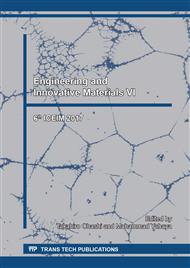p.208
p.213
p.218
p.225
p.230
p.235
p.241
p.246
p.254
Preliminary Study on Reaction of Fresh Concrete with Carbon Dioxide
Abstract:
In order to let fresh concrete react with carbon dioxide sufficiently, the carbon dioxide was added to mixing concrete. The study used three water cement ratio (0.55, 0.65, 0.75), three CO2 pressures (0.2, 0.4, 0.6 MPa), and two CO2 concentration (50% and 100%) to make concrete samples, and observed the effect of carbon dioxide adsorption in the above parameters. Finally, the compressive strength and carbonation degree of concretes were tested after three curing time (7, 14 and 28 days). The research showed that concrete could be more efficient to absorb carbon dioxide by using this pressure method. The results found that the mixing concrete react with carbon dioxide in a short time, and shorten the initial setting time of concrete. But this method would greatly reduce the workability of concrete after mixing with carbon dioxide and it might be enhanced by water or superplasticizer. The bond of cement matrix might cut down after reacting with carbon dioxide. Based on the above, the compressive strength of concrete which was mixed with carbon dioxide would be impaired. The proposed CO2-mixing method has the capacity to uptake 9.5% carbon dioxide based on water cement ratio and CO2 pressure.
Info:
Periodical:
Pages:
230-234
Citation:
Online since:
January 2018
Authors:
Keywords:
Price:
Сopyright:
© 2018 Trans Tech Publications Ltd. All Rights Reserved
Share:
Citation:


